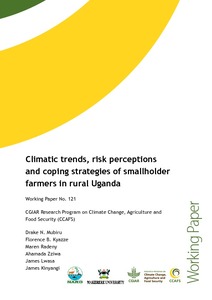Resource information
Smallholder farmers in Uganda face a wide range of agricultural production risks, with climate change and variability presenting new risks and vulnerabilities. Climate related risks such as prolonged dry seasons have become more frequent and intense with negative impacts on agricultural livelihoods and food security. This paper assesses farmers’ perceptions of climate change and variability and analyses historical trends in temperature and rainfall in two rural districts of Uganda in order to determine the major climate-related risks affecting crop and livestock production and to identify existing innovative strategies for coping with and adapting to climate-related risks, with potential for up-scaling in rural districts. The traditional coping strategies that have been developed by these communities overtime provide a foundation for designing effective adaptation strategies.
Drought, disease and pest epidemics, decreasing water sources, lack of pasture, bush fires, hailstorms, changes in crop flowering and fruiting times were the major climate-related risks reported across the two districts. Farmers use a wide range of agricultural technologies and strategies to cope with climate change and climate variability. Mulching, intercropping and planting of food security crops were among the most common practices used. Other strategies included water harvesting for domestic consumption, other soil and water conservation technologies and on-farm diversification. Farmers often use a combination of these technologies and practices to enhance agricultural productivity. The average maximum temperatures increased across the two districts. Trends in average annual rainfall showed mixed results with a general decline in one district and a relatively stable trend in the other district. Perceived changes in climate included erratic rainfall onset and cessation, which were
either early or late, poor seasonal distribution of rainfall and little rainfall. Farmers also reported variations in temperatures. Farmers’ perception of changing rainfall characteristics and increasing temperatures were consistent with the observed historical climatic trends from meteorological data.


